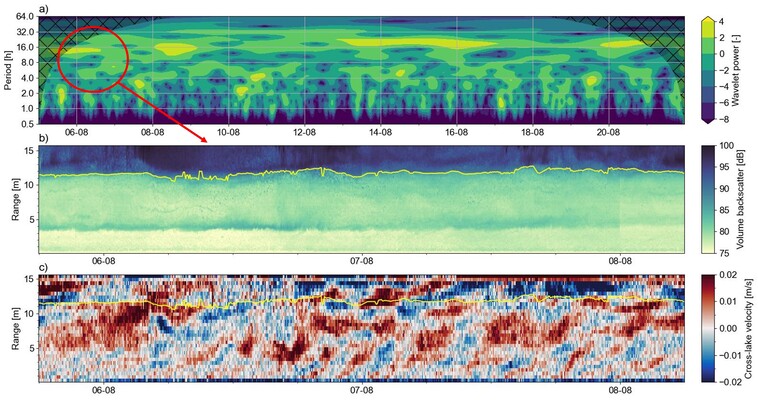P. J. de Bruijn*1, H. M. Clercx1 , W. M. Kranenburg1,2, M. Daugharty3
1 Delft University of Technology,The Netherlands; 2 Deltares, The Netherlands; 3Nortek Netherlands, The Netherlands.
* Corresponding author: P.J.deBruijn@tudelft.nl
Introduction
Many enclosed former estuaries experience water quality problems. The problems are related to stratification, which inhibits the downward mixing of dissolved oxygen to the deep former estuarine channels and pits, leading to hypoxia. Former estuaries like Lake Veere and Grevelingenmeer have also seen events of massive fish mortality, presumably related to the wind-driven upwelling of deep water. To unravel these dynamics, we require more insight into the spatiotemporal behaviour of the stratification.
Stratification is currently measured through fortnightly temperature-salinity-oxygen transects with measurement points every few kilometres. These often do not capture all relevant dynamics, such as mixing and internal oscillations of isopycnals (e.g., tilting, seiching). Echosounding, which overcomes these issues, has been used extensively in the ocean to monitor stratification (Brenner et al., 2023; Shibley et al., 2020), but has seen limited use in lakes, where scatterers are often scarce. Potential scatterers include impedance gradients (i.e., stratification, air bubbles), biota, and turbulence (Bassett et al., 2023). The current generation of acoustic Doppler current profilers (ADCPs) allows for multi-frequency echosounding in combination with the usual velocity, providing new opportunities to acoustically monitor stratification.
Objective and Methods
This study aimed to integrate acoustic and mooring data to develop a method to monitor stratification at a high spatiotemporal resolution. Subsequently, we used this method to characterize internal oscillations of the thermocline. In the summer of 2024, measurements were collected with two up-looking ADCPs, three underwater moorings equipped with thermistorchains, and a high-resolution conductivity-temperature-depth (CTD) casting instrument. The ADCP measured backscatter at three narrowband frequencies: 1000, 500, and 250 kHz, a wide bandwidth that we expected to facilitate the distinction between backscatter mechanisms at a high spatial resolution.
We compared direct temperature measurements by moorings, CTD casts, and acoustic backscatter at multiple frequencies to characterize backscatter mechanisms in Lake Veere. We used the acoustic backscatter to monitor stratification by tracking (gradient) maxima. We compared acoustically derived thermocline heights to the thermocline heights inferred from the temperature moorings. Finally, we used the monitored stratification to characterize internal seiching by combining data from several locations. To that end, we analysed the time series of thermocline heights using the continuous wavelet and wavelet coherence transforms to identify periods of internal seiching. We validated the latter using the current profiles measured by the ADCPs.
Results
We only observed stratification of the upper water column in the acoustic data during extended warm periods. The upper and lower layers were separated by a gradient in backscatter, with increased backscatter in the upper water column. This gradient coincided with the directly measured main thermocline, demonstrating the potential of monitoring the thermocline height through acoustic backscatter. We hypothesize that the large gradient (as opposed to a local maximum) was caused by a difference in phytoplankton concentration (Warren et al., 2003), which remained above the thermocline due to buoyancy effects and bloomed during extended warm periods. We did not observe impedance gradients; instead, we attribute backscatter maxima to suspended matter aggregating on isopycnals (Haught et al., 2024). We found periods of both cross-lake and along-lake internal seiching in thermocline heights through increased coherence and out-of-phase behaviour between measurement locations. Additionally, vertical shear in the internal seiching frequency band was a sporadic indicator of thermocline height, but not as consistent as for basins of a more regular shape (Simpson et al, 2021). Our results demonstrate the potential of characterizing stratification in former estuaries using acoustic backscatter.

a) Wavelet spectrum of the thermocline height inferred from one of the ADCPs. The marked area represents a spell of internal seiching, with a forced oscillation followed by a free oscillation. We zoom in on b) the measured volume backscatter during this spell and on the c) cross-lake velocities. The thermocline height, derived from the volume backscatter in (b), is shown in yellow.
References
Bassett, C., Lavery, A. C., Ralston, D., Geyer, W. R., Jurisa, J. T., Thomson, J., Honegger, D. A., Simpson, A., Scully, M. E., and Haller, M. C. (2023). Acoustic backscattering at a tidal intrusion front. Progress in Oceanography, 219:103167.
Brenner, S., Thomson, J., Rainville, L., Torres, D., Doble, M., Wilkinson, J., and Lee, C. (2023). Acoustic Sensing of Ocean Mixed Layer Depth and Temperature from Uplooking ADCPs. Journal of Atmospheric and Oceanic Technology, 40(1):53–64.
Haught, D. R. W., Stumpner, P., Burau, J., Violette, T., and Conlen, A. (2024). Suspended particulate matter mixing in the Low Salinity Zone of the San Francisco Estuary, California. In Bay-Delta Conference Proceedings, Sacramento, California.
Shibley, N. C., Timmermans, M.-L., and Stranne, C. (2020). Analysis of Acoustic Observations of Double-Diffusive Finestructure in the Arctic Ocean. Geophysical Research Letters, 47(18):e2020GL089845.
Simpson, J., Woolway, R., Scannell, B., Austin, M., Powell, B., and Maberly, S. (2021). The Annual Cycle of Energy Input, Modal Excitation and Physical Plus Biogenic Turbulent Dissipation in a Temperate Lake. Water Resources Research, 57.
Warren, J. D., Stanton, T. K., Wiebe, P. H., and Seim, H. E. (2003). Inference of biological and physical parameters in an internal wave using multiple-frequency, acoustic-scattering data. ICES Journal of Marine Science, 60(5):1033–1046.


